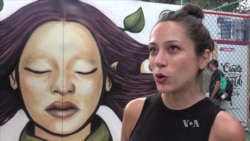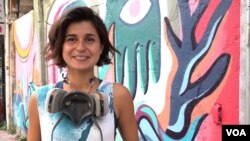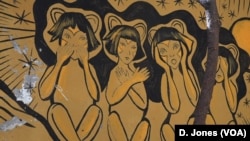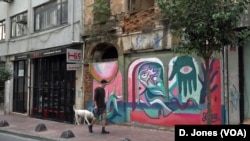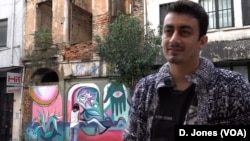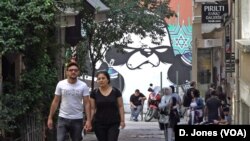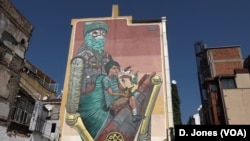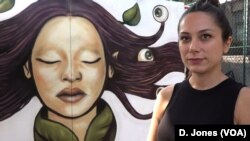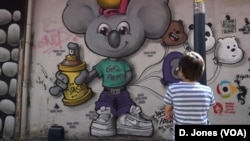Istanbul is seeing an explosion of creative graffiti, with women artists largely behind the blast of color that is sweeping Turkey’s main city in the face of what critics say have been mounting restrictions on expression.
“More and more, the new generation are very into painting on the streets, but for me it is still very much at the beginning,” said Gamze Yalcin, who has been putting her art on the city’s public places.
“As we are having more and more limits for our street life from what we used to have,” she said, “people want to see colors, they want to see art. Whatever you do on the street is a gift for everyone.”
Yalcin speaks to VOA as she applies the finishing touches to her latest work, on the wall of a derelict building in Istanbul’s trendy Tophane district.
The latest work spanning 10 meters is a myriad of images and symbols in pastel colors with an abstract depiction of a woman at the center, encompassing a range of themes found throughout Yalcin’s work.
“We have very limited parks, so green areas is always a subject I like to include with symbols of plants and greens,” she said explaining her work, a myriad of surreal colors.
For Yalcin, featuring women as a central theme represents female empowerment, she says, and “a symbol, for all the women, that they could do whatever they want. They can do their dreams, they can make it true.”
Painting Istanbul’s walls for the past six years, Yalcin - a classically trained artist - is a veteran of Istanbul’s fledgling graffiti world. She is also one of a growing number of women graffiti artists, a trend she is busy building on.
“I organize workshops, [which] women, girls are very much into, and they always come and attend to learn,” she said.
“I feel very lucky that as a female artist painting on the street wherever I go, that brings so much power and so much inspiration,” she adds. "Whatever you do on the street is a gift for everyone, so they [people] are really taking as a gift, and they feel connected.”
While graffiti in many parts of the world is generally seen as vandalism and a nuisance, here, for this genre of it, there is appreciation.
People regularly stop, to offer Yalcin encouragement as she paints, while others take photos of her work.
“These are not ordinary doodling, but something that makes the places more beautiful,” said Ulas a local restaurant manager, “coloring the walls and shop fronts is beautiful rather than having shutters down or derelict walls bare. This is much more colorful. When you wake up in the morning streets, look much different. I think this is super.”
Despite a heavy police presence in central Istanbul as part of an ongoing crackdown on political dissent, the graffiti wave sweeping parts of the city has met little resistance from authorities.
“I didn’t have trouble yet, and I hope it goes like this,” Yalcin said. “Sometimes they [police] see me, they say actually it is forbidden, but that is fine. And they say ‘thank you, thank you for creating art for our places,’” she adds, laughing.
Observers say such police tolerance can in part be explained by the fact that most graffiti artists stay away from overt political themes. Although the recent jailing of Ezel, a Turkish rap star, on charges of encouraging drug use, saw some graffiti artists pushing back with images of support.
On the Asian side of Istanbul, the Kadikoy municipality invites local and international graffiti artists to decorate neighborhood.
Walking around Kadikoy, a traditional center of opposition to the government, one is regularly struck by huge murals adorning the sides of the buildings. The images range from psychedelic colored tigers or huge robots to abstract pictures of utopian worlds.
Graffiti art is becoming an integral part of the city’s popular culture. At an art and cartoon festival in Istanbul this month, the graffiti section made up of women artists is among the most popular.
Graffiti artist Fulya Fu creates a surreal image of a woman whose hair is decorated with eyes; many watching Fu are young teenagers.
“[A] majority [of graffiti artists] are youngsters who started at a very early age, around 12-13,” said Fu, and they start from the street, inside the street culture, perhaps going out at night. They start from scratch and pursue graffiti. Also, there are also lots of people coming from the art scene, fine arts. Many artists try this once in a while,” she said.
Fu is among a growing number of artists making a living from graffiti. Decorating cafes and doing corporate work for companies seeking to catch the halo effect of the coolness of street art, is becoming increasingly lucrative. None of the artists interviewed was willing to say how much each of their works fetches.
Despite the commercialization of graffiti it still retains a cutting edge as one of few remaining outlets for public expression.
“The art is constantly evolving with what we are experiencing,” said Fu.
“Since the space of freedom we experienced 10 years ago has become more restricted,” she continued, “and graffiti is already seen as an illegal, so what people express, tell, even scream with their work will likely be a reaction and reflection of these changes.”
“In the past, we perhaps saw more simple writings ideas,’ but now it's evolving. People are trying to form new sentences, new ideas, to express more,” she said.




